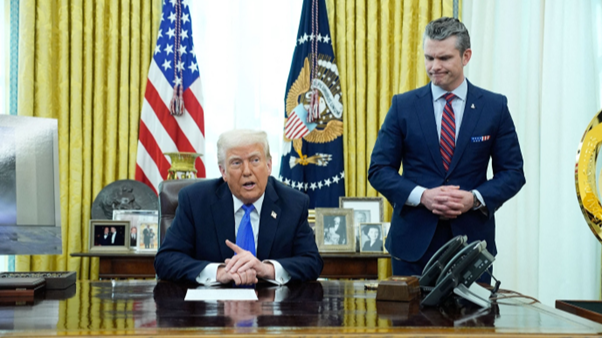By continuing to browse our site you agree to our use of cookies, revised Privacy Policy and Terms of Use. You can change your cookie settings through your browser.
I agree
Search Trends
CHOOSE YOUR LANGUAGE
- Albanian Shqip
- Arabic العربية
- Belarusian Беларуская
- Bengali বাংলা
- Bulgarian Български
- Cambodian ខ្មែរ
- Croatian Hrvatski
- Czech Český
- English English
- Esperanto Esperanto
- Filipino Filipino
- French Français
- German Deutsch
- Greek Ελληνικά
- Hausa Hausa
- Hebrew עברית
- Hungarian Magyar
- Hindi हिन्दी
- Indonesian Bahasa Indonesia
- Italian Italiano
- Japanese 日本語
- Korean 한국어
- Lao ລາວ
- Malay Bahasa Melayu
- Mongolian Монгол
- Myanmar မြန်မာဘာသာ
- Nepali नेपाली
- Persian فارسی
- Polish Polski
- Portuguese Português
- Pashto پښتو
- Romanian Română
- Russian Русский
- Serbian Српски
- Sinhalese සිංහල
- Spanish Español
- Swahili Kiswahili
- Tamil தமிழ்
- Thai ไทย
- Turkish Türkçe
- Ukrainian Українська
- Urdu اردو
- Vietnamese Tiếng Việt
Copyright © 2024 CGTN.
京ICP备20000184号
CHOOSE YOUR LANGUAGE
- Albanian Shqip
- Arabic العربية
- Belarusian Беларуская
- Bengali বাংলা
- Bulgarian Български
- Cambodian ខ្មែរ
- Croatian Hrvatski
- Czech Český
- English English
- Esperanto Esperanto
- Filipino Filipino
- French Français
- German Deutsch
- Greek Ελληνικά
- Hausa Hausa
- Hebrew עברית
- Hungarian Magyar
- Hindi हिन्दी
- Indonesian Bahasa Indonesia
- Italian Italiano
- Japanese 日本語
- Korean 한국어
- Lao ລາວ
- Malay Bahasa Melayu
- Mongolian Монгол
- Myanmar မြန်မာဘာသာ
- Nepali नेपाली
- Persian فارسی
- Polish Polski
- Portuguese Português
- Pashto پښتو
- Romanian Română
- Russian Русский
- Serbian Српски
- Sinhalese සිංහල
- Spanish Español
- Swahili Kiswahili
- Tamil தமிழ்
- Thai ไทย
- Turkish Türkçe
- Ukrainian Українська
- Urdu اردو
- Vietnamese Tiếng Việt
Copyright © 2024 CGTN.
京ICP备20000184号
互联网新闻信息许可证10120180008
Disinformation report hotline: 010-85061466






















Containers are seen at the Port of Baltimore in Maryland, the United States. /Xinhua
Editor's note: In April, the White House announced sweeping tariffs to revitalize American manufacturing. But will production indeed return to U.S. soil as the Trump administration hopes? CGTN has launched a five-part "Return of American Manufacturing?" series to explore this question. The fourth installment examines the harms of Washington's illusion of manufacturing repatriation.
Stephen Ndegwa, a special commentator for CGTN, is the executive director of South-South Dialogues, a Nairobi-based communications development think tank. The article reflects the author's opinions and not necessarily the views of CGTN.
In April, U.S. President Donald Trump reignited his protectionist campaign by announcing sweeping new tariffs targeting nearly all imported goods. Branded as a bold attempt to bring back American manufacturing, the policy is being sold to the public as a silver bullet for job creation, economic revival, and the restoration of "Made in America."
But beneath the populist rhetoric lies a sobering reality. The illusion of manufacturing repatriation is not only misleading; it actively threatens the very industries it claims to rescue. The logic behind high tariffs is simple but dangerously flawed. By making foreign products more expensive, the policy aims to push companies to produce domestically. Yet this overlooks the deeply globalized nature of modern manufacturing.
U.S. industries, especially in high-tech and advanced manufacturing, depend heavily on imported intermediate goods including components, machinery, and raw materials that are often unavailable or not affordable within American borders.
According to the National Association of Manufacturers, nearly 60 percent of U.S. imports are intermediate goods used in domestic production. Taxing these inputs through tariffs raises production costs for U.S. manufacturers, making their final products less competitive both at home and abroad. Ironically, a policy designed to protect American industry ends up weakening it.
Consider the electronics sector, where U.S. firms rely on intricate global supply chains that span continents. Apple, for example, designs its products in California but relies on precision components from Japan, South Korea and other regions, with final assembly in China and Vietnam. Despite efforts to onshore operations, high-tech manufacturing continues to migrate to regions offering greater efficiency, talent availability, and supportive infrastructure, none of which can be replaced by tariffs alone.
Workers remove the blocks around an Apple store on Fifth Avenue during the reopening in New York, the United States, June 12, 2020. /Xinhua
Moreover, the jobs that do return are largely in low value-added sectors such as food processing, textiles and basic chemicals. These positions are vulnerable to automation and offer limited wage growth or innovation spillover. This is hardly the kind of manufacturing renaissance promised on campaign stages.
According to the U.S. Bureau of Labor Statistics (BLS), manufacturing employment is projected to experience minimal growth over the next decade. Net job creation in the manufacturing sector is expected to remain virtually flat, even under optimistic scenarios.
In this context, the Trump administration's tariff-heavy strategy reflects a nostalgic, outdated vision of industry. It clings to the myth that America can rebuild its industrial base simply by walling itself off from the world economy. But as global value chains become more integrated, such isolationist policies risk turning "Made in America" into a hollow slogan that inflates costs, reduces competitiveness, and stifles innovation.
The economic warning signs are already flashing. Earlier this month, Goldman Sachs raised its estimate for a U.S. recession over the next 12 months from 20 percent to 35 percent, citing aggressive tariff policies as a potential trigger.
Tariffs function like a tax on consumers and businesses, driving up prices and fueling inflation. A study by the Peterson Institute for International Economics estimated that the average American household paid an extra $1,200 annually due to Trump-era tariffs, a figure likely to rise if new measures are enacted.
So far, China, the EU, and Canada have imposed retaliatory tariffs in response to new U.S. trade barriers, hitting key American exports. These moves are already straining U.S. sectors like agriculture, manufacturing and aerospace.
True revitalization of American manufacturing requires far more than punitive trade measures. It demands sustained investment in education, infrastructure and research and development (R&D). The U.S. currently spends just 0.7 percent of GDP on public R&D, less than half the share it did in the 1960s, during its last industrial heyday.
Policies must focus on upgrading industrial capabilities, enhancing advanced technologies, and integrating U.S. production into high-value segments of the global economy. The goal should not be to return to a bygone era but to build forward into a more competitive, sustainable future.
Viewing tariffs as a catch-all solution, the Trump administration's policies risk turning a complex industrial challenge into a political talking point. In doing so, they undermine the very industries they claim to support and weaken the global credibility of "Made in America." It is not enough to bring factories back.
The real question is, what kind of factories, what kind of jobs, and what kind of future is the U.S. building?
(If you want to contribute and have specific expertise, please contact us at opinions@cgtn.com. Follow @thouse_opinions on X, formerly Twitter, to discover the latest commentaries in the CGTN Opinion Section.)